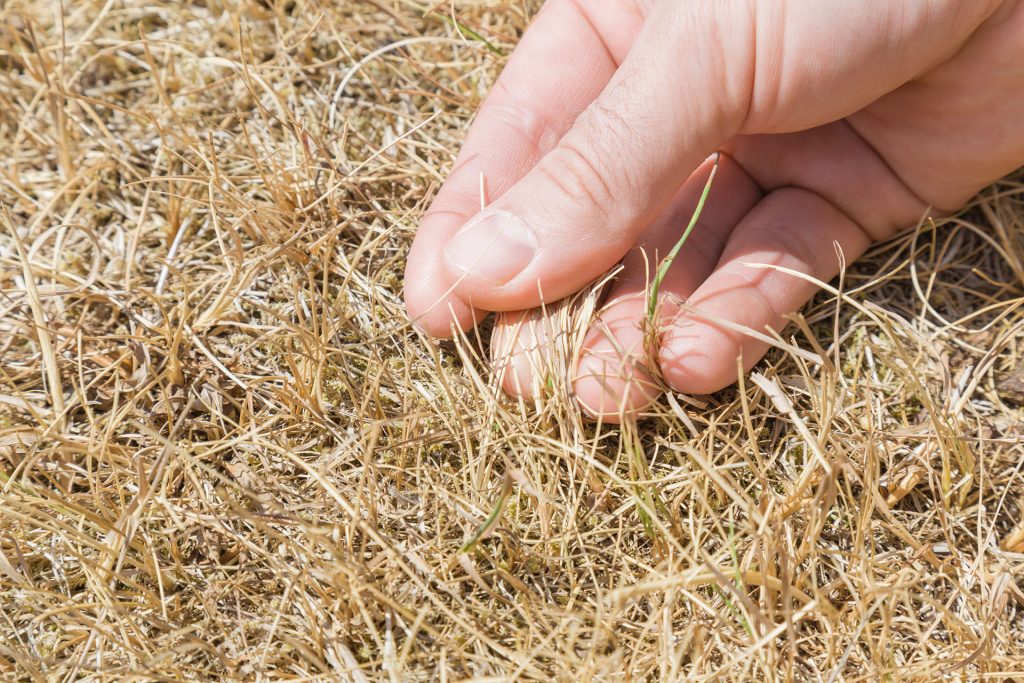
Hot summers and scarce rain can really do a number on your lawn.
As the dry heat drags on, and days turn to weeks, your lawn will slowly wilt and turn brown.
But don’t despair. A dormant lawn is not a dead lawn.
With the right care, your lawn can survive a drought and come back lush and green as soon as the water comes back.
Preparing for Drought
While droughts are an inevitable part of summer, there are things you can do ahead of time to lessen the blow.
With the right preparation, you can keep your lawn green as long as possible, even when the rain has stopped.
![Caring for Your Lawn Before, During, and After a Drought [infographic]](https://theturfgrassgroup.com//wp-content/uploads/2020/09/Caring-for-Your-Lawn-Before-During-and-After-a-Drought-infographic.jpg)
Rainwater Collection
If you rely on rain to water your lawn, you may find that the changing weather has a strong effect on your lawn’s health.
When it rains, there’s more than enough water, but your lawn can get parched when it doesn’t.
But what if there was a way to keep the extra water from a rainstorm and use it later?
Of course, that is entirely possible. All it takes is a little preparation.
You can build a rainwater collection system yourself or purchase one at a local garden or home-improvement store.
A rainwater collection system’s essential parts are a catchment area, like your roof, a transportation method, like your gutters, and a storage system, like a giant barrel.
Some states regulate rainwater collection, so be sure to check the local laws before you start.
If you purchase a rainwater capture system from a store, it will include an appropriate basin that connects to your gutter and a spigot to attach a garden hose to water your lawn.
If you build your own system, make sure that the basin has a cover because uncovered standing water invites mosquitoes and other pests who lay their eggs in standing water.
With a rainwater collection system, you can collect 500 gallons of water per 1,000 square feet or catchment area for every inch of rain.
If your lawn is half the size of your roof, one inch of rain can provide enough water to water your lawn twice (assuming you provide the standard one-inch of water per watering).
If your yard is equal to your roof, one-inch of rain equals on watering, and so on.
It’s easy to see how this kind of water collection can go a long way toward fending off drought, as long as you have enough storage.
Smart Irrigation
During a drought, local regulations may limit how much you can irrigate your lawn if you can irrigate at all.
Stored rainwater isn’t included in the limits on irrigation, but even if you don’t have rainwater, you can water more efficiently with smart irrigation.
Surprisingly, when homeowners water their lawns, most of that water is actually wasted by overwatering and runoff.
The simplest way to increase your watering efficiency is to water in the early morning, between 4 a.m. and 10 a.m., before the hottest part of the day.
Watering while it is cooler reduces evaporation, so your lawn can absorb more precious water.
But watering in the morning instead of the late afternoon or evening gives your grass time to dry before the sun sets, which is important because leaving your grass wet overnight creates an ideal condition for fungus growth.
If you want to make your irrigation even smarter, you can purchase a smart irrigation system.
Smart irrigation systems use digital technology to control when and how much you irrigate your lawn.
The systems are controlled via WiFi and respond to water and soil conditions to deliver just the right amount of water.
Ideal Soil Conditions
Part of preparing for a drought is preparing your soil to handle water as efficiently as possible.
Sandy soil doesn’t hold water well, and water can drain out of the soil before your grass can absorb it.
Clayey soil is dense and does not absorb water well, leading to pooling and runoff.
The best soil is loamy soil, containing equal parts clay, sand, and silt, plus humus or organic matter like manure or compost.
Loamy soil can absorb and hold water so that it can fully penetrate, and the grass roots have time to absorb it.
If your soil is too sandy, you can improve it by adding silty organic matter.
If it is too clayey, start by aerating and then add organic matter to loosen it up.
What to Do During a Drought
Once drought sets in, it is only a matter of time before your grass wilts and goes brown.
When this happens, your grass isn’t dead. It’s just dormant.
Dormancy is actually beneficial to your lawn.
It is your turf’s way of shutting down non-essential activities like new top growth and focusing on storing water and energy to preserve the roots and crown.
Most grass can remain dormant for 2 to 3 weeks. Some hardy varieties, like TifTuf Bermudagrass, can last even longer.
But how you treat your lawn during a drought can affect how well it recovers when the water returns.
Monitor for Signs of Stress or Disease
The first sign of stress from drought is a change in the color of your lawn.
Your grass may darken before it goes brown. Also, watch for signs that your grass isn’t holding as much water as it normally would.
Healthy grass will spring back up after you walk on it. But drought-stressed grass will show footprints after you step away.
To make sure your grass is still healthy, even during drought, look at the white area at the plant’s base.
If it remains off-white, the plant is healthy.
If it has begun to turn brown, your turf is in desperate need of water to prevent it from dying.
As your grass is stressed and goes dormant, it becomes more susceptible to disease.
Keep an eye out for opportunistic weeds, and spot treat them with a selective herbicide.
If you catch weeds early, you can also remove them by hand with a simple spade.
Dethatch
Thatch, the layer of undecomposed organic matter that collects just above the soil, is helpful when it is about a half-inch thick.
It can insulate the soil and help maintain moisture. But when it gets thicker, thatch can keep water from reaching the plant roots.
If your turf has built up a thick layer of thatch, you can dethatch with a special sharp metal rake or vertical mower.
While too much dethatching can hurt an already stressed lawn, removing thatch can also help your lawn use what little water it can get.
Watering During a Drought
If a drought drags on long enough, you will need to give your turf at least some water to keep it alive.
It’s best not to water dormant grass too often, as waking grass from its dormancy can actually waste stored resources.
Dormant grass needs one-half to one-quarter inch of water every two to four weeks to stay alive.
Keep Off the Grass
To prevent damage, it is best to keep off the grass during a drought.
Drought-stressed grass doesn’t recover well from foot traffic, so minimizing traffic during a drought is crucial.
Mowing During a Drought
A common question is how or if you should mow during a drought. The answer depends on what stage of drought and dormancy your grass has reached.
Early on, it is a good idea to cut your grass a little longer. Longer grass blades help shade the soil, reducing evaporation and heat damage.
Grass will grow more slowly during a drought, so you may not have to mow as often.
The principle to keep in mind is that you should never cut more than the top third of your grass.
As you mow, leave the grass clippings on the lawn to return vital moisture and nutrients to the soil. Once the grass has gone completely dormant, it will stop growing, and you don’t need to mow at all.
What to Do After a Drought
When a drought is over, the most important thing to do is reintroduce water to your lawn.
By definition, a drought breaks when it rains, so your lawn’s first watering after a drought will be natural.
But once you can return to irrigating your lawn, it is important to water correctly.
Watering deeply and less frequently forces roots to grow deep and reach as much water as possible.
Avoid shallow watering because it causes roots to spread out just beneath the soil and results in weaker turf.
Drought-Tolerant Turf
The best way to prepare for a drought is to grow a drought-tolerant turf variety.
The Turfgrass Group sells some of the most drought-tolerant varieties available.
TifTuf Bermudagrass is exceptionally drought-tolerant and uses less water than other bermudagrass varieties.
Drought study testing in 2011 revealed that TifTuf used 38% less water, retaining 95% more green leaf tissue in drought stress as compared to Tifway. Find a grower here.
Conclusion:
In the face of hot summers and scarce rain, maintaining a lush, green lawn can be challenging, but it’s not impossible.
With proper preparation, smart irrigation practices, and vigilant care during droughts, you can ensure your lawn survives and comes back to life when water returns.
Utilizing rainwater collection systems, adopting smart irrigation technology, and optimizing soil conditions are key strategies for lawn care enthusiasts.
Additionally, understanding the signs of stress, employing timely treatments, and making informed decisions about mowing and foot traffic during a drought are crucial aspects of preserving your lawn’s health.
FAQs:
Can a dormant lawn recover after a drought?
Yes, a dormant lawn is not dead; it’s a survival mechanism. With proper care, including reintroducing water and monitoring for signs of stress, your lawn can recover and thrive once the drought ends.
How can rainwater collection help during a drought?
Rainwater collection systems allow you to store rainwater for later use. This collected water can be used to irrigate your lawn during dry periods, providing a sustainable water source independent of external supplies.
What is the best time to water the lawn during a drought?
The early morning, between 4 a.m. and 10 a.m., is the ideal time to water your lawn during a drought. Watering at this time minimizes evaporation, allowing your grass to absorb more water, and it allows the grass to dry before night, preventing fungal growth.
How can I improve my soil’s water-holding capacity during a drought?
For sandy soil, add silty organic matter to improve water retention. For clayey soil, aerate and add organic matter to enhance drainage. Loamy soil, containing equal parts clay, sand, and silt, is the most effective for water absorption.
Should I mow my lawn during a drought?
Yes, but adjust your mowing practices. Cut the grass a bit longer to shade the soil, reducing evaporation. During early drought stages, grass grows more slowly, so you may not need to mow as often. Avoid cutting more than the top third of the grass, and leave clippings on the lawn to return moisture and nutrients to the soil.
What should I do immediately after a drought breaks?
After a drought breaks, the first watering will likely be natural. Once you can resume irrigation, water deeply and less frequently to encourage deep root growth. Shallow watering should be avoided, as it leads to weaker turf with shallow roots.
Is there a type of grass that is more tolerant to drought?
Yes, choosing a drought-tolerant turf variety is an excellent strategy. TifTuf Bermudagrass, for example, has proven to be exceptionally drought-tolerant, using less water and retaining more green leaf tissue during drought stress compared to other varieties.
